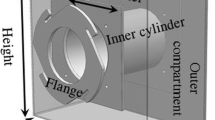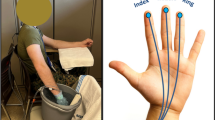Abstract
The purpose of this work was to integrate a new mathematical model with a bioheat model, based on physiology and first principles, to predict thermoregulatory arterio-venous anastomoses (AVA) and cold-induced vasodilation (CIVD) reaction to local cooling. The transient energy balance equations of body segments constrained by thermoregulatory controls were solved numerically to predict segmental core and skin temperatures, and arterial blood flow for given metabolic rate and environmental conditions. Two similar AVA–CIVD mechanisms were incorporated. The first was activated during drop in local skin temperature (<32 °C). The second mechanism was activated at a minimum finger skin temperature, T CIVD, min, where the AVA flow is dilated and constricted once the skin temperature reached a maximum value. The value of T CIVD,min was determined empirically from values reported in literature for hand immersions in cold fluid. When compared with published data, the model predicted accurately the onset time of CIVD at 25 min and T CIVD,min at 10 °C for hand exposure to still air at 0 °C. Good agreement was also obtained between predicted finger skin temperature and experimentally published values for repeated immersion in cold water at environmental conditions of 30, 25, and 20 °C. The CIVD thermal response was found related to core body temperature, finger skin temperature, and initial finger sensible heat loss rate upon exposure to cold fluid. The model captured central and local stimulations of the CIVD and accommodated observed variability reported in literature of onset time of CIVD reaction and T CIVD,min.







Similar content being viewed by others
Abbreviations
- A :
-
Area, m2
- AVA :
-
Arterio-venous anastomoses
- c :
-
Specific heat of blood, J/kg⋅K
- C :
-
Thermal capacitance for each body segment, J/K
- CIVD :
-
Cold-induced vasodilation
- h c :
-
Convection heat transfer coefficient, W/K · m2
- h e :
-
Evaporation heat transfer coefficient between the skin and the air, W/kPa · m2
- M :
-
Basal metabolic rate, W
- \( \dot{m} \) :
-
Blood flow rate, kg/s
- n :
-
Number of data points
- P :
-
Vapor pressure, kPa
- q :
-
Sensible heat loss , W
- Q :
-
Heat loss or exchange, W
- t :
-
Time, s
- T :
-
Temperature, °C
- TMSD :
-
Root Mean Square Deviation
- W :
-
Mechanical work done by the body, W
- a:
-
Artery
- adjacent:
-
Adjacent node in the previous body segment
- amb:
-
Ambient
- artery:
-
Artery
- AVA:
-
Arterio-venous anastomoses
- bl:
-
Blood
- CIVD:
-
Cold-induced vasodilation
- c:
-
Reference to skin and air convection
- cr:
-
Core
- cr − sk:
-
Core and skin contact
- exp:
-
Experimental value
- finger:
-
Finger
- min:
-
Minimum
- model:
-
Model
- o:
-
Initial value of parameter upon immersion in cold fluid
- perf:
-
Perfusion
- r:
-
Radiative
- res:
-
Respiration
- sk:
-
Skin
- sk, exp:
-
Exposed skin
- shiv:
-
Shivering
- sur:
-
Surface
- vein:
-
Vein
- vein, s:
-
The superficial vein
- α:
-
Coefficient, which is 1 for the chest and zero for all other body parts
- τ:
-
Time constant of the AVA response (s)
References
ASHRAE Handbook of Fundamentals (2009) American Society of Heating Refrigerating and Air-Conditioning Engineer. ASHRAE Inc, Atlanta
Avolio AP (1980) Multi-branched model of the human arterial system. Med Biol Eng Comp 18:709–718
Bergersen TK, Hisdal J, Walløe L (1999) Perfusion of the human finger during cold-induced vasodilatation. Am J Physiol 276(3, Pt. 2):R731–R739
Brajkovic D, Ducharme MB (2001) Maintaining finger dexterity in the cold: a comparison of passive, direct and indirect hand heating methods. RTO HFM Symposium on Blowing Hot and Cold: Protecting Against Climatic Extremes, held in Dresden, Germany, 8–10 October 2001, and published in RTO-MP-076
Castellani JW, O’Brien C (2005) Peripheral vasodilation responses to prevent local cold injuries. In Prevention of Cold Injuries (pp. KN2–1 – KN2–14). Meeting Proceedings RTO-MP-HFM-126, May 2, 2005, Keynote 2. Neuilly-sur-Seine, France: RTO
Castellani JW, Young AJ, Ducharme MB, Giesbrecht GG, Glickman E, Sallis RE (2006) Prevention of cold injuries during exercise. Med Sci Sports Exerc 38(11):2012–2029
Chen F, Liu ZY, Holmer I (1996) Hand and Wnger skin temperatures in convective and contact cold exposure. Eur J Appl Physiol Occup Physiol 72:372–379
Cheung SS, Mekjavic IB (2007) Cold-induced vasodilatation is not homogenous or generalizable across the hand and feet. Eur J Appl Physiol 99:701–705
Daanen HAM (1991) Arterio-venous anastomoses and thermoregulation. Report No. IZF 1991 B-12, TNO Institute for Perception Group: Thermophysiology, Soesterberg, Netherland, 1991
Daanen HAM (2003) Finger cold-induced vasodilation: a review. Eur JAppl Physiol 89:411–426
Daanen HA, Ducharme MB (1999) Finger cold-induced vasodilation during mild hypothermia, hyperthermia and at thermoneutrality. Aviat Space Environ Med 70:1206–1210
Daanen HAM, van der Struijs N (2005a) The Risk Index for frostbite. In Prevention of Cold Injuries. Meeting Proceedings RTO-MP-HFM-126, Paper 13: 13-1 – 13-10. Neuilly-sur-Seine, France: RTO. May 2005
Daanen HAM, van der Struijs NR (2005b) Resistance index of frostbite as a predictor of cold injury in arctic operations. Aviat Space Environ Med 76(12):1119–1122
Daanen HAM, van de Linde FJG, Romet TT, Ducharme MB (1997) The effect of body temperature on the hunting response of the middle finger skin temperature. Eur J Appl Physiol 76:538–543
DeGroot DW, Castellani JW, Williams JO, Amoroso PJ (2003) Epidemiology of U.S. Army cold weather injuries, 1980-1999. Aviat Space Environ Med 74:564–570
DuCharme MB, Brajkovic D (2005) Risk of frostbite and CIVD on the face during cold wind exposure. Defense Research & Development, Canada, RTO-MP-HFM-168
Flouris AD, Westwood DA, Mekjavic IB, Cheung SS (2008) Effect of body temperature on cold induced vasodilation. Eur J Appl Physiol 104:491–499
Flouris AD, Cheung SS (2009) Influence of thermal balance on cold-induced vasodilation. J Appl Physiol 106:1264–1271
Geurts CLM, Sleive G, Cheung SS (2005) Effect of cold-induced vasodilatation in the index finger on temperature and contractile characteristics of the first dorsal interosseus muscle during cold-water immersion. Eur J Appl Physiol 93:524–529
Giesbrecht GG, Jamieson C, Cahill F (2007) Cooling hyperthermic fire fighters by immersing forearms and hands in 10°c and 20°c water. Aviat Space Environ Med 78(6):561–567
House JR, Michael AE, Tipton J (2002) Using skin temperature gradients or skin heat flux measurements to determine thresholds of vasoconstriction and vasodilatation. Eur J Appl Physiol 88:141–145
Iida T (1949) Studies concerning vascular reaction to cold (Part 1), Physiological significance of vascular reaction to cold. J Physiol Soc Jpn 11:73–78
Ishigaki H, Horikoshi IT, Uematsu T, Sahashi M, Tsuchikawa T, Mochida ST, Hieda T, Isoda N, Kuno SH (1993) The convective heat transfer coefficient of the human body is essential to predict convective heat loss from the body. J Therm Biol 18(5/6):455–458
Iyoho AE, Jang T, Nair SS (2009) Human thermal model with extremities for asymmetric environments. ASHRAE Trans 115(1):484–495
Johnson JM, Pergola PE, Liao FK, Kellogg DL Jr, Crandall CG (1995) Skin of the dorsal aspect of human hands and fingers possesses an active vasodilator system. J Appl Physiol 78(3):948–954
Kaciuba-Uscilko H, Greenleaf GE (1989) Acclimatization to cold in humans, National Aeronautics and Space Administration (NASA), EASA-TB- 10 10 12
Karaki W, Ghaddar N, Ghali K, Kalev K, Holmer I, Vanguard LL (2013) Human thermal response with improved AVA modeling of the digits. Int J Therm Sci 67:41–52
Koscheyev VS, Paul S, Leon GR, Tanchida D, Taylor TJ, Koscheyev IV (1998) Body surface temperature tuning as a comfort support system in space and other extreme environments. SAE Technical Paper Series 981723. In Proceedings of the 28th International Conference on Environmental Systems, July 13–16, Danvers, MA, pp. 1–8, 1998
Kuennen MR, Gillum TL, Amorim FT, Kwon YS, Schneider SM (2010) Palm cooling to reduce heat strain in subjects during simulated armored vehicle transport. Eur J Appl Physiol 108:1217–1223
Kuklane K, Smolander J, Holmér I, Vanggaard L (2011) Does reduced heat production during mild whole body cooling override increased heat generation by pre-shivering muscle tension? XIV International Conference on Environmental Ergonomics, Nafplio, Greece, July 10-15, 2011
Lewis T (1930) Observations upon the reactions of the vessels of the human skin to cold. Heart 15:177–208
Miura T, Kimotsuki K, Tominaga Y, Suzuki Y (1977) Effect of environmental conditions on the cold-induced vasodilation of office workers and forestry workers. J Science of Labor 53:75–81
Rubinstein EH, Sessler DI (1990) Skin-surface temperature gradients correlate with fingertip blood flow in humans. Journal of Anesthesiology 73(3):541–545
Salloum M, Ghaddar N, Ghali K (2007) A new transient bio-heat model of the human body and its integration to clothing models. Int J Therm Sci 46(4):371–384
Sawada S (1996) Cold-induced vasodilatation response of finger skin blood vessels in older men observed by using a modified local cold tolerance test. Ind Health 34:51–56
Sawada S, Araki S, Yokoyama K (2000) Changes in cold-induced vasodilatation, pain and cold sensation in fingers caused by repeated finger cooling in a cool environment. Ind Health 38:79–86
Sendowski I, Sarourey G, Besnard Y, Bittel J (1997) Cold induced vasodilatation and cardiovascular responses in humans during cold water immersion of various upper limb areas. Eur J Appl Physiol Occup Physiol 75(6):471–477
Sharp MW, Hamlet MP (1988/9) Peripheral circulatory effects of cold stress and smoked or chewed tobacco products measured by infrared thermography. US Army Research Institute of Environment Medicine, Natick, MA (unpublished)
Shitzer A, Bellomo S, Stroschein LA, Gonzalez R, Pandolf KB (1998) Simulation of a cold-stressed finger including the effects of wind, gloves, and cold-induced vasodilatation. J Biomed Eng 120:389–394
Shitzer A, Stoschein LA, Vital P, Gonzalez RR, Pandolf KB (1997) Numerical analysis of an extremity in a cold environment including countercurrent arterio-venous heat exchange. J Biomech Eng 119:179–186
Smith CE (1991) A transient three-dimensional model of the thermal system, PhD thesis, Kansas State University
Takemori T (1995) A fundamental model of the human thermal system for prediction of thermal comfort. Heat Transfer-Japanese Research 24(2):147–165
Teichner W (1966) Individual thermal and behavioral factors in cold-induced vasodilatation. Psychophysiology 2(4):295–304
Van der Struijs NR, Van Es EM, Raymann RJEM, Daanen HAM (2008) Finger and toe temperatures on exposure to cold water and cold air. Aviat Space Environ Med 79:941–946
Vanggaard L, Kuklane K, Holmer I, Smolander J (2012) Thermal responses to whole-body cooling in air with special reference to arteriovenous anastomoses in fingers. Clin Physiol Funct Imaging 32(6):463–469
Wilson O, Goldman RF (1970) Role of air temperature and wind in the time necessary for a finger to freeze. J Appl Physiol 29(5):658–664
Author information
Authors and Affiliations
Corresponding author
Rights and permissions
About this article
Cite this article
Rida, M., Karaki, W., Ghaddar, N. et al. A new mathematical model to simulate AVA cold-induced vasodilation reaction to local cooling. Int J Biometeorol 58, 1905–1918 (2014). https://doi.org/10.1007/s00484-014-0792-x
Received:
Revised:
Accepted:
Published:
Issue Date:
DOI: https://doi.org/10.1007/s00484-014-0792-x




